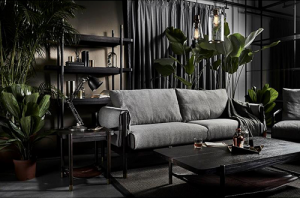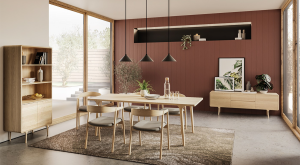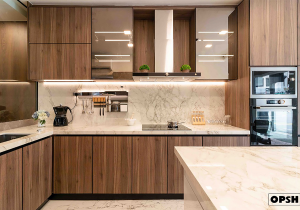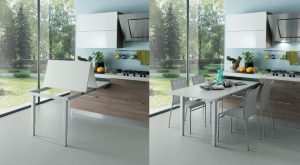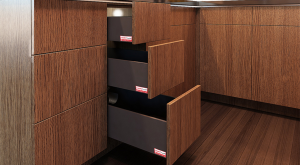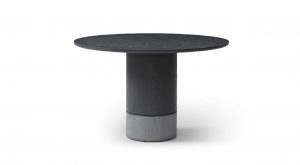Design Crusader of Hong Kong Culture & Heritage: Interview with Douglas Young of G.O.D./Hong Kong
A designer who is equally passionate about his art as much as he is about his home country. A patriot can show their love for their nation in many ways, and for Douglas Young of G.O.D., it is through his design that captures the unique spirit and mood of Hong Kong often in unexpected and unapologetic ways. We sat down with Douglas for a no-holds-barred interview, where he shared his views on his designs, his thoughts, his journey, and his beauty secrets.

Part 1: An Advocate for Hong Kong Culture & Heritage
1)G.O.D turns 25 this year, it’s a real achievement for a homegrown brand. What are some of the strategies to ensure the longevity and success of your brand?
Do things that are authentic and unique to us, things that only we have the authority to do. That will ensure that even if we have rivals, they will not be able to exceed us in authenticity. For example, a lot of our designs are based on my personal experiences and traditions passed down to me, so only I have the authority to draw from them. I can comment and play with my own culture and my own identity and nobody else can do that. In Hong Kong, culturally-driven works are not common. Of course, my works are self-designed and self-inspired, but they have their roots in traditions. I don’t necessarily follow fashion per se or get inspired by other designs so I’m very much working on my own and inventing my own things. This results in original designs which give my products an authenticity.
2)You have been a strong advocate of Hong Kong culture and heritage, and infusing them into your design; against a backdrop of increasingly westernised youngsters. Do you feel it has gotten easier or harder for G.O.D.? Do you feel it is a one-man battle sometimes?
It feels absolutely like a one-man battle sometimes. But I believe that throughout the years we have created this style, or this “trend” towards a local Hong Kong style and more importantly, a recognition of this unique Hong Kong style. It is by no means mainstream but we do have our fans and, for me, that is already enough. We have been on the cutting edge of this trend and I don’t expect things that are cutting edge to have mass appeal. I’ve never wanted our products to be for the mass market.
3)Do you think the government could have done anything to help in preserving and promoting Hong Kong culture and heritage?
The government can always do more. I think the government has done a good job of preserving our built heritage. A lot of old heritage buildings have been preserved. Unfortunately, they stop at preservation, and not regeneration of buildings. The government can find more ways to inject life into our heritage. It is one thing to preserve, but it is also important to inject life so that the spirit of tradition may be extended and made exciting for the next generation to continue it.
There are many examples of how history can be made fun and be enlivened with the participation of young people, such as doing new businesses in old buildings – mixing old and new. I see many examples of that in Thailand, Taiwan, China and Japan, with Japan being the leader in preserving heritage, in my opinion.
4)Do you feel that the mentality of the young generation in Hong Kong are very different from the era where you were from?
Yes – every generation is different. My generation is different to my mother’s generation who had been through the war and experienced extreme poverty. My generation is probably the first generation that didn’t have to worry about where our next meal would come from. Generally, everyone had a good education. Of course, our mindsets will be different.
This current generation has grown up with Hong Kong being one of the world’s richest cities. That comes with its own challenges. We are being so well provided for in an unprecedented way. I think the pressure on today’s generation is on how to better our lives. That would be a real challenge because in many ways, our lives are already better than ever before.
Whereas for my parents, it would not have been as difficult to better their lives as they started at a much lower baseline. The challenge for today’s kids is that everything is so expensive now. The barrier to entry to pursue their dreams and start new businesses is very high. The cost of failure is also very high. In many ways, today’s kids are fortunate to have it so good but at the same time, the challenges are also greater than ever before.
5)As a designer and retailer, how do you keep informed of the youth’s buying preferences?
I like to collaborate with those from the younger generation. I like to work with people who are vastly different from me. Hopefully, I will gain insight from them as I pass my knowledge and experiences to them. So it’s an experience or wisdom exchange. I learn from them and they learn from me.
6)Are there other Hong Kong designers who are equally passionate about this preservation and promotion propaganda?
Propaganda?! I would dispute the word propaganda. The use of the word propaganda suggests that we are not sincere in what we are doing and that isn’t true. I can only speak for myself and I can tell you that I am very sincere and passionate about our heritage and our identity. I think many Hong Kong designers are equally passionate, even though they might be doing different things such as film, fashion, graphics etc.
7)Over the years, do you think you have succeeded in instilling some love (in Hong Kongers in general) for the local culture? You have shops abroad, do you think it is harder to sell the Hong Kong culture to her people than to the outsider?
Our legacy would be that we have started a trend towards grassroots local culture, design and style. I do see a revival of Hong Kong style. When I first started, people told me this was a hopeless cause as there is no such thing as Hong Kong style. I think we have proven them wrong. We have shown them there is a Hong Kong style.
In some ways, yes it is harder to sell Hong Kong culture to her people. We are so familiar with our style and culture that they end up being mundane or ordinary. We don’t see the extraordinary in the ordinary, so in some ways, it is difficult to sell to local people. But having said that there are local people that are like me, we have overseas backgrounds and experiences and we know what Hong Kong’s strengths and weaknesses are, so nothing is simply ordinary to us. I believe these people and sophisticated overseas buyers will be able to appreciate G.O.D. designs.
Part 2: The Making of a Designer
8)You went to the UK when you were 14, can you share the memories of your childhood? Did you grow up in an environment of creativity?
I was born and brought up in Hong Kong. My parents are not in the creative industry but I have always been creative since a young age. I found that the Hong Kong education system at that time was very stifling – concentrating too much on academia and less on creativity so when my parents chose to send me to school in the UK at the age of 14, it was a huge emancipation for me. I discovered freedom and the chance to explore my creative side and it was only then that I started to become passionate about pursuing a career in the creative field.
9)You spent your formative years in the UK and came back more than a decade later – how have the years in the UK mould you as a designer?
London in the 1980s was very much at the forefront of world culture in many ways – the fashion scene, the music scene, the Young British Artists were all very influential. I consider myself very lucky to have been right in the heart of all those movements. It was amazing to witness the development of the kind of energy that was taking place in this cultural capital of the world. To this day, I am hugely influenced by that. I don’t want to repeat what they have done because Hong Kong is a different place, but a commonality is that sense of energy, and that sense of risk-taking when it comes to creating things. That spirit is very similar to Hong Kong.
I’ve benefited from the British education – not necessarily from the academic side but more so from things that are seemingly unimportant such as television programmes. I remember situation comedies were very popular in the UK and their sense of humour and self-deprecation really influenced me. This was a very important lesson for me because I use it in my creativity.
10)Were your parents supportive of your choice to be a designer and start your brand in 1996? Were you expected to take over the family business?
I am very lucky to have very supportive parents both from a financial and a moral point of view. They were very supportive. Sadly, a lot of Hong Kong people would consider themselves lucky if their parents did not stop them from pursuing their passions, let alone be as supportive as mine. I’m doubly fortunate and it’s this sense of good fortune that makes me really want to do it well so that I don’t waste my good fortune.
We don’t have a family business per se so I consider that fortunate too.
11)G.O.D. started in a warehouse, can you share with us your early days?
When we started in 1996 similar to today, rental prices were very high and the only available spaces were far out away from town centres. We came across this deserted warehouse building which was a 20-minute drive from the town centre, but it had a car park and amazing views and was simply a great space with a ceiling height of 10 metres. Most importantly, it had very cheap rent so we took it. People thought we were crazy as it was so far removed from the city, but we soon proved people wrong. People came to buy from us and because they travelled all that way, they did actually buy rather than just browse. It was a risk but we were just starting out, so taking a risk was necessary to make a splash. I guess when you debut you can’t do it quietly.

12)The SCMP once bestowed you with the accolade “King of Kitsch” – even though I read that you were a little annoyed at first, but I feel that it is an honour cos not everyone can be a King of something and Kitsch can be fun and witty too; and you had also shared that people have said that you are a rich boy playing poor and that your products are designed for “Gweilos”, your 14K T-shirts had also stirred quite a commotion – in a way it is great because as you said, art calls for a response from its audience, and your designs have no lack of response – now that you are older and looking back at all these, what is your reflection on all these incidents and how do you feel as a veteran designer now?
I feel proud to have gone through these experiences even though some of them were harrowing at the time when it happened, but they make me who I am and I truly own them. Life is nothing without ups and downs. I embrace the ups as well as the downs. It’s also what you make of them. For example, the 14K example brought us notoriety but also made us into a household name. If I had handled it badly, I could have ended up in jail or lost public sympathy, but luckily it all went in our favour.
I don’t think I took the King of Kitsch reference badly. People assumed that I would take it badly because it was a pejorative / epithet. I don’t consider what I do as being kitschy but I can understand why people say that. We often take traditional Chinese motifs or designs and improvise or play around with them; and to Western sensibilities, traditional Chinese designs are bright red and can be gawdy which can equate to being kitsch. The designers that I admire – such as Philippe Starke – took French tradition in his case, and gave it a modern twist. I think it’s unfair that he’s never been called kitsch. Why is it that when it comes to Chinese designs we are labelled as kitsch? It is a double standard. We are just so used to Chinese traditions being equated to kitschiness, and that is an unfair type of prejudice and assumption. I am here to right that wrong. It is time that we looked at our traditions and designs in a positive light and not denigrate them.
My products might seem too ordinary for local people. For people who have been living in Hong Kong all the while, they might not be able to appreciate Hong Kong the same way people who have been away or visitors from overseas do. For the outsider, the eccentricities and uniqueness of Hong Kong would be special because they see Hong Kong with a fresh pair of eyes and how it is different from where they come from.


Part 3: Impact of Covid-19 & Political Unrest
13)There has been some political unrest and protests in Hong Kong in recent years, has that affected your practice as a designer? Do you think design has the power to effect change in the area of politics?
It has definitely impacted our retail business as the protests reduced tourism to Hong Kong. A lot of our business was based on foreign visitors so that really affected our shops.
The soft power of design is that we can make our culture appealing and attractive to outsiders in an age where there is a lot of hatred and attacks on Asians. Asians can do more with soft power in terms of design, fashion, music – popular culture – to make us more appealing. This is where the creative industry can help.
14)Being a very vocal designer, have you considered using design as a channel for meditating or as a platform to convey messages in these difficult times?
I don’t think it can be used that way. Some do it but I don’t necessarily see a way to do it. I think people are very suspicious of designers trying to play outright politics. As designers, our power is in our work.
15)How is the design scene like in Hong Kong right now? Has it seen any significant changes due to Covid-19?
As people have not been able to travel, there is a lot of local tourism. More people are exploring and discovering places in Hong Kong which may well lead to an awakening of our local identity. They are visiting local shops and neighbourhoods and exploring the countryside.
A lot of international brands have also been retreating or downsizing which may create more opportunities for local brands. No longer do we have to compete with them for retail spaces, hopefully that will effect some drop in rental and spaces can be more affordable.

16)With Covid-19 and the protests, the retail scene is much disrupted, how does G.O.D. cope with that?
We are developing things that are appropriate for COVID-19 such as reusable face masks and accessories that are associated with eco-friendly face masks. A lot of people are making single-use face masks which will have a huge adverse impact on our environment.
We have worked on building our e-commerce business to try and cope with the drop in visitors to our physical stores as most are still cautious about going to crowded shopping spaces.
17)Did you buff up on marketing your online shops during the Covid-19 & the periods of protests?
Yes, we had to.
18)What is roughly the percentage of sales from physical shops and online shop?
Our online sales still constitute a smaller percentage as compared to our retail sales but it has certainly grown significantly over the last 18 months. We are investing more into our online shop and hope to keep the growth going. When the pandemic first hit, there was a shortage of face masks globally so we were getting orders from all over the world which resulted in a positive surge in overseas interest – some of whom have never been to Hong Kong.
19)When was your online shop first launched? What were some of the teething problems you faced at first?
We’ve always had an online store in some form or other for as long as I can remember. At first, we had a proprietary site that looked nice but was cumbersome to update. At that time, you needed an IT specialist to work on a website, unlike today where there are a lot of platforms and programmes that are more intuitive and user-friendly.
One of the biggest challenges was getting Hong Kong people to shop online – to gain traction. Because Hong Kong is so small, a lot of people would prefer to go to a physical store. We are a bit behind a lot of countries in adopting online shopping.
20)What are some of the lessons you learnt from your e-commerce venture?
That it is not the cheap alternative that it once was. It’s probably more costly to run than a physical store including the rent and staff costs. I think a lot of people treat e-commerce as the ‘cheap’ way of selling things but it’s not. It’s an expensive operation if you want to do it well.
The need to constantly update and promote it. It is very difficult to gain a voice amongst this crowd of competition. I find that is easier when there is a personality behind it – someone that is real and living that life. That is why I am very upfront when it comes to my social media. I am very much always a spokesperson to sell what I do appealingly. It sets a differentiation.
21)How different is it selling online and in physical shops?
I think our products are designed to be mixed and matched, so the curation and presentation are very important to set the mood and show the possibilities. It’s very difficult to do it online because everything is seen as an individual item. Whereas when you come to a G.O.D. store, you see everything coming together as a collection and you experience the mood, and you get it. It is very difficult to set a sense of mood online.
22)SEOs are hard to control and driving traffic to one’s online shop has always been a big challenge for most e-commerce. What was your marketing strategy for your e-commerce shops?
To have a social media that supports it – have content that is complementary, entertaining and compelling. Create content that is habit-forming for our customers so they would want to return to our pages.
We also make sure that our physical stores help to promote the online store particularly to overseas visitors who may want to shop with us again when outside of Hong Kong.
23)What is your bestseller online and what is your bestseller in the physical shops?
Fashion in our physical stores is one of the best-selling categories as people like to come in and try or feel the pieces. We are currently focussing on giving our customers the comfort and peace of mind to buy apparel online with better photo angles and more detailed measurements.
As for our online shop, homeware is a big seller for our local customers. We offer free shipping to Hong Kong-based customers with a minimum spend so they can order the heavier items such as dinnerware and get these delivered to them; whereas the cost of shipping heavy ceramics overseas may be less attractive for our overseas clientele.
For overseas customers shopping online, they tend to purchase fashion-related items such as T-shirts, masks, bags, and stationery items – our signature prints and humorous designs are the bestsellers for online overseas customers.


24)Do you think there will come a day where G.O.D goes completely online?
I hope not. The online experience will be always complimentary, but I think essentially we will always be a physical store. I enjoy customer interaction, I like running a physical store and having physical displays. I like having people touch and feel things and experience moods in an architectural space. I was an architect by training so I like physical things.
25)You have shops in other countries, do you feel that they might become less necessary with e-commerce being a popular channel of retail now?
Yes, I do. When I travelled pre-COVID19, I always made it a point to seek out the local shops. I wanted to experience the local culture and retailers. I would never want to be perceived as a chain store that exists in every city in the world.
26)The global retail scene has been disrupted by e-commerce. What is your take so far on physical expansion vs online expansion?
I think online expansion has greater potential to grow than physical expansion, particularly in a place like Hong Kong where rental prices are so high and it is very difficult to get good spaces.
Part 4: Evolution of a Brand
27)What keeps you going for over 2 decades?
My sense of not having felt success. I feel that there is still so much more work that needs to be done and I am not there yet. I still haven’t succeeded in my mind.
Many people would say that what I am doing seems to be leading to a destination. But I have yet to find that destination. The more I explore, the more I see, the more I am inspired and see that there is so much more to do so I am still not running out of inspiration. I guess the day when I wake up and think, “I don’t have any inspiration in me”, that is when I should stop. That day hasn’t arrived yet.
28)How has the brand and business evolved over the years?
I was trained as an architect but I felt that architecture in Hong Kong was boring. I then did a bit of interior design and through interior design, I was doing home products and furniture. I gradually realised that the brand I wanted to build was not about furniture, it should be a Hong Kong brand with Chinese and Hong Kong aesthetics and identity. I came to realise I was not limited to just furniture. I could do clothing, food, anything really, that are related to Hong Kong. It was not about the product but the philosophy behind this brand, which is about updating and humourizing local traditions.
29)You have designed a huge range of things – from homeware to stationery to furniture to clothes and fashion accessories – which is your favourite and why?
My favourite is the one that I am not good at. I like the process of learning and perfecting my skills. If I feel that I can do something easily, it is not enjoyable. So my favourite at the moment is fashion because I am still working it out.
30)Is there anything else you want to try but have yet to do it? What’s holding you back?
I would love to do a more environmental project such as a hotel or a restaurant. Something that allows a person to immerse themselves in an environment that I have created – even an Airbnb. A place where people live a lifestyle through my eyes – everything from the built environment to the furniture, the food, the music, the smells, the aesthetics, the art is all done through me. It would be a very expensive project and that’s stopping me- the expense!
31)The content of your products over the decades have been consistently and unapologetically about Hong Kong, have you ever thought of having a spin-off line or brand that is culturally-neutral?
No, there’s so much left to do! I need to focus. I like things that are culturally focussed and I like other cultures too, but the reason why I am doing what I am doing is to remain focussed.
32)What was the lowest and highest point for you in this journey of running G.O.D.?
I thought long about this question. I thought about the awards we’ve won and the mentions in international media such as Time and CNN, Wallpaper and the New York Times trying to figure out the high but in the end, it was the creation of the ‘Yaumati’ print fabric. It was the first design that we created that had a very Hong Kong aesthetic. Before that, everything was for the furniture business, and those items are very neutral in design. The fact that it was such a hit, got me very excited. I realised that there was a market out there for this kind of thing and gave me the confidence to do more. I created this print for myself – a personal hobby so it was exciting to realise that I was not crazy and other people liked it too.
The lowest is probably right now, because at this moment everything is so challenging, it is almost a life-and-death situation business-wise. So either we are going to get through this or we are not.


33)Where do you see G.O.D. in 10 years time?
I would like G.O.D. to still play an important role and still be central to the HK creative scene. It need not necessarily be in retail. We could be doing other things such as a hotel as I mentioned or a restaurant or be a part of the West Kowloon District.
Part 5: Last Questions
34)Bucket list question – Is there anything or things you would like to do in life, which you haven’t yet?
Currently, I am writing a novel. I think all great cities need great stories. Hong Kong has had great stories and we need to update some of these stories. It’s not related to what I do, but I would like to write a great Hong Kong story.
35)What is your advice for aspiring young designers in Hong Kong?
To be conscious of our limitations. It’s very easy to fall into the trap of admiring popular designers say, Thomas Heatherwick and wanting to be Hong Kong’s Thomas Heatherwick. Be conscious of the fact that you can’t be that in Hong Kong. Thomas Heatherwick had different opportunities when he built his career and we simply don’t have those same opportunities in Hong Kong. Forget that dream and do it your way. Recognise the strengths and weaknesses of Hong Kong, and make the most out of that combination.
36) Last question – at 56, seriously you don’t look it at all and still as leng-zai (translates as “pretty boy” in Cantonese) as when I first met you 20 years ago, can you please share with us your beauty secrets?
Sleep and Laugh! Sleep is very important. I sleep at least 8 hours a day. A lot of my friends complain that I sleep too much but I sleep a lot. Sleep really does regenerate me. Sleep a lot. Laugh a lot.
[by Kelley Cheng]
28 March 2021


